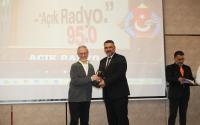14 May 2008Jean-Marc Vittori, Les Échos
A prestigious evening newspaper endures one strike after another. A former telephone service administration launches into satellite television. An ordinary citizen destabilizes the President of the Republic by revealing his irritation at the Agriculture Salon over the Internet. Thus does the new media world emerge: in which former landmarks disappear one after the other, where everyone is looking for its new brand names, where uncertainty has never been so great. The economy of which needs to be reinvented.
Before, everything was simple - or nearly so.
A media outlet was fed by two pipelines. The first brought the money paid by the consumer. The reader bought "France-Soir." The television viewer paid his share at Canal+. The Internet user footed his AOL subscription. The second pipeline was plugged into the advertiser, who bought advertising to promote his products or image. Europe 1 and TF1 are connected to this sole financing source. Most newspapers and magazines are "bifacial," simultaneously sold to readers and advertisers. And that has been the case for a very long time: in 1909, a year after the creation of "Les Echos," a third of its front page vaunted "true Benedictine liqueur." A television channel like Canal+ also rounds out its revenues with advertising. To tell the truth, a third pipeline exists, plugged into the taxman. Public money finances the press a little through assistance (reduced value added tax, discounted freight rates, social and fiscal deductions for journalists). It broadly finances the public audiovisual sector - today the entirety of FIP radio and tomorrow: television channel France 2 - according to the President of the Republic.
This age-old economic structure is about to be swept away. One the one hand, the consumer pays less and less for the news. Free newspapers, once confined to ads, today include real daily newspapers such as "20 Minutes" or "Metro." Above all, the Internet is wrecking the previous state of affairs. There's no longer any need to buy a newspaper to know the results, whether Michelin's quarterly earnings or those of the Cholet-Roanne basketball game. A few clicks suffice. Basic news is becoming a "commodity," a raw material with a price close to zero. Logically, what economists call the consumers' "agreement to pay" is declining.
On the other hand, the advertiser is doing ever more soul-searching. "I waste half of the money I spend on advertising; the problem is I don't know which half." That remark - attributed to John Wanamaker, an American retail magnate at the beginning of the Twentieth Century - is losing its relevance. With the Internet and "data mining," the management of gigantic electronic data bases, specialists measure advertising's impact with growing precision. Advertisers balk at paying rates elaborated from limited tools such as audience measures. They will attempt to pay commissions calculated as a function of their messages' effectiveness. And they will switch their spending in favor of the most effective media. The leader of a big American company very involved in this sector estimates that global Internet advertising could double in five years, from 40 to 80 billion dollars. Simultaneously, the annual 500 billion dollars spent on all advertising could drop by 15 to 20 percent.
But the shock doesn't stop there. The media planet is undergoing two other disruptions. The first is the passage from scarcity to abundance. Thirty years ago, France counted three television channels and barely more radio stations. First, there was regulatory change in the 1980s when "free" radio stations were authorized and then the launch of Canal+. Then came technical change with satellites, the signal compression that allowed an increase in the number of channels (TNT) and, above all, the Internet. The number of channels exploded and with it, the race for consumers and advertisers. On top of that, new tools appeared. While there were only three big innovations during the 20th century (the large scale production and distribution of the written press at the beginning of the century, radio and television starting in the 1930s, the Internet in the 1990s), today, changes are unremitting: computer, BlackBerry, iPod, cell phones receiving television, e-papers etc. Without even mentioning the tools that allow the consumer to compose his own à la carte menu (podcast, video on demand, community video sites etc.). As always, competition makes prices fall. And the media, which are not "the little engine that could," are all, or almost all, declining. TF1's audience has sunk below 30 percent of the total. Newspaper sales are suffering continuous erosion ...
The second shock is the reduction in market entry cost. The creation of a web site costs a few thousand Euros, that of a newspaper or television channel, a thousand times more. And its distribution is automatically global from the outset, while traditional media have to invest a lot of money to broaden their geographic coverage. Consequently, new actors can appear more easily. There also, competition intensifies.
Consumers and advertisers who want to pay less, ever more numerous and varied competitors ... In the face of these revolutions, uncertainty has become radical. One infallible sign: LBO investment funds have been virtually unwilling to consider cases within the sector for the last two to three years. Since they borrow so much money to finance their purchases, they need to have practically guaranteed turnover to repay their loans. In fact, it's the news production "business model" that must be reinvented. There will always be a need for people to find, verify, prioritize, and put news into perspective - journalists. But where will the money come from? For now, no one knows. In the United States, some experts are even talking about financing.... by patrons.
We can, of course, cite a few leads. The English weekly, "The Economist," is in great shape because it offers the opposite of basic news, with brilliant journalists paid on the scale of investment bankers. The daily newspaper "L'Agefi," once published in large format, has outsourced its printing to ... its customers. Its readers now receive a PDF file on their computer that they can print themselves. In the United States, the magnate Rupert Murdoch who bought the daily "Wall Street Journal," wants multimedia journalists who simultaneously work for the paper, the Net and television. A number of media are also taking the wrecking ball to their organization, going from a pyramidal organigram to an hourglass structure with hired hands and experts. In the next ten years, the economy of the media will change even more than it has during the last century.
--------
Leslie Thatcher is Truthout's French language editor.
http://www.truthout.org/article/media-an-economy-that-needs-reinventing






